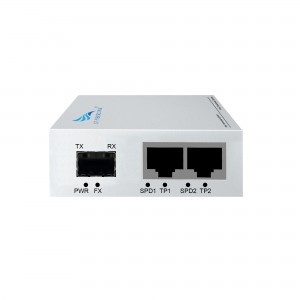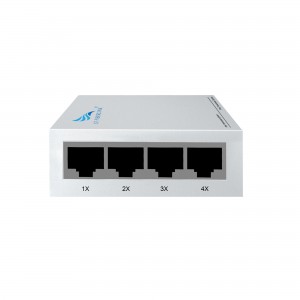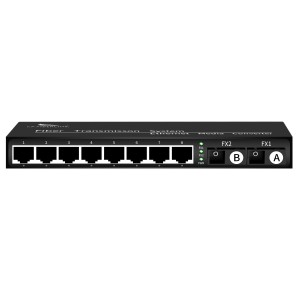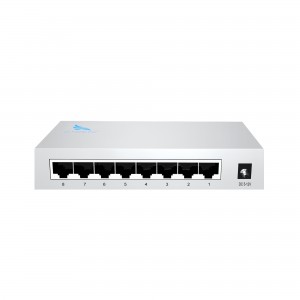3-port 10/100/1000M WDM Media Converter (Single-mode Single-fiber SC)B-end
3-port 10/100/1000M WDM Media Converter (Single-mode Single-fiber SC)B-end
Product Features:
Introducing the latest innovations in optical transceiver technology
We are pleased to launch our latest product, 1 Optical 2 Electrical Single Mode Single Fiber Gigabit Transceiver A Side, 3 Port Single Mode Single Fiber Gigabit Optical Switch. Developed by Huizhou Changfei Optoelectronics Technology Co., Ltd., a well-known leader in total transmission solutions, this cutting-edge optical-to-electrical converter sets new standards in performance and functionality.
At Huizhou Changfei, we are committed to providing top-tier transmission solutions to our global clients, backed by our commitment to excellence and customer satisfaction. With rich R&D expertise and multiple scientific research patents for optoelectronic products, our reputation has grown exponentially. We have won unanimous praise from more than 360 dealers and agents in more than 100 countries around the world.
Our 1 Optical 2 Electrical Single Mode Single Fiber Gigabit Transceiver A Side, 3 Port Single Mode Single Fiber Gigabit Optical Switch combines the best of optical technology for a seamless and efficient networking experience. The transceiver is equipped with DC5-12V wide voltage power supply range, ensuring versatility in various installation environments. In addition, the port supports 4KV lightning protection, protecting your network from unpredictable weather conditions and power surges.
The transceivers are designed to withstand extreme temperatures and perform flawlessly even in challenging environments. Whether it’s scorching heat or freezing cold, you can rely on our products for uninterrupted communication. In addition, our transceivers support 10KB jumbo frames, enabling faster and more efficient data transfers.
We understand the importance of saving energy, which is why our transceivers have low power consumption. By utilizing only necessary energy, we conserve valuable resources while reducing our customers’ operating costs.
Ease of use is our top priority and our 4-digit dial and dynamic LED indicators make configuration and monitoring a breeze. The SC interface ensures a safe and stable connection, while the plug-and-play function eliminates cumbersome installation procedures. The iron shell design ensures durability, while the IP30 rating keeps dust and debris out.
To give you maximum flexibility, our transceivers come with an external power supply, making them compatible with various setups. Regardless of application or infrastructure, our products integrate seamlessly into your network.
To sum up, Huizhou Changfei Optoelectronics Technology Co., Ltd.’s 1-optical, 2-electric single-mode single-fiber gigabit transceiver A side, 3-port single-mode single-fiber gigabit optical switch is a game-changing transmission solution in the industry. With its advanced features, ease of use and commitment to energy efficiency, this product is sure to revolutionize your network infrastructure. Believe in our professional knowledge, join the ranks of countless enterprises around the world, and experience the cutting-edge technology and excellent service that only Huizhou Changfei can provide. Upgrade your network today and explore a whole new world of possibilities.
What This Product Does
◇ CF-1012GSW-20B is a gigabit media converter, providing a gigabit RJ-45 port and a gigabit SC fiber port, which can convert between electrical and optical signals.
How This Product Works
◇ CF-1012GSW-20B adopts WDM (wavelength division multiplexing) technology, helping send and receive data at a distance of up to 20 km with only a single mode fiber, which saves half of the cable deployment cost for customers. CF-1012GSW-20B transmits data at 1310 nm wavelength and receives data at 1550 nm wavelength on optical fiber. Therefore, the terminal device used in conjunction with the CF-1012GSW-20B should send data at a wavelength of 1550 nm and receive data at a wavelength of 1310 nm. CF FIBERLINK another media converter CF-1012GSW-20A is one of the products that can cooperate with CF-1012GSW-20B.
Other Features
◇ In addition, the media converter can be used as a standalone device for automatic MDI/MDI-X in the TX port, where duplex mode is automatically negotiated.
technical parameter:
| Model | CF-1012GSW-20B | |
| Interface Characteristics | ||
|
Fixed Port |
2* 10/ 100/ 1000Base-T RJ45 port
1* 1000Base-X uplink SC fiber port |
|
| Ethernet Port | 10/ 100/ 1000Base-T auto-sensing, full/half duplex MDI/MDI-X self-adaption | |
|
Twisted Pair Transmission |
10BASE-T: Cat3,4,5 UTP(≤100 meter)
100BASE-T: Cat5e or later UTP(≤100 meter) 1000BASE-T : Cat5e or later UTP(≤100 meter) |
|
| Optical Port | Default optical module is single-mode single-fiber 20km, SC port | |
| Wavelength/Distance | A-end: RX1310nm / RX1550nm 0 ~ 40KM
B-end:RX1550nm/ RX1310nm 0 ~ 40KM |
|
| A-end: RX1490nm / RX1550nm 0 ~ 120KM
B-end:RX1550nm/ RX1490nm 0 ~ 120KM |
||
| Chip Parameter | ||
| Network Protocol | IEEE802.3 10BASE-T, IEEE802.3i 10Base-T,
IEEE802.3u 100Base-TX, IEEE802.3u 100Base-FX, IEEE802.3x IEEE802.3ab 1000Base-T;IEEE802.3z 1000Base-X; |
|
| Forwarding Mode | Store and Forward(Full Wire Speed) | |
| Switching Capacity | 6Gbps | |
| Buffer Memory | 4.5Mpps | |
| MAC | 2K | |
|
LED Indicator |
Fiber | FX(green) |
| rate | SD/SPD1 (green)
SPD2: 100/1000 (green) |
|
| Data | TP1/TP2 (green) | |
| Power | PWR (green) | |
| Power | ||
| Working Voltage | AC:100-240V | |
| Power Consumption | Standby<1W, Full load<5W | |
| Power Supply | DC:5V/2A industrial power supply | |
| Lightning protection &Certification | ||
| Lightning protection | Lightning protection: 4KV 8/20us, Protection level: IP30 | |
| Certification | CCC;CE mark, commercial; CE/LVD EN60950;FCC Part 15 Class B; RoHS | |
| Physical Parameter | ||
| Operation TEMP | -20~+55°C;5%~90% RH Non condensing | |
| Storage TEMP | -40~+85°C;5%~95% RH Non condensing | |
| Dimension (L*W*H) | 94mm* 71mm*27mm | |
| Installation | Desktop | |
Product Size:
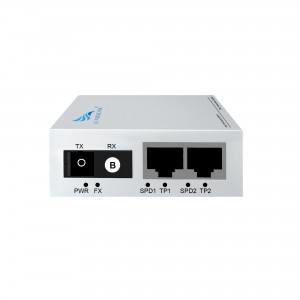
Product application diagra:

How to choose a fiber optic transceiver?
Optical fiber transceivers break the 100-meter limitation of Ethernet cables in data transmission. Relying on high-performance switching chips and large-capacity caches, while truly achieving non-blocking transmission and switching performance, they also provide balanced traffic, isolation and conflict. Error detection and other functions ensure high security and stability during data transmission. Therefore, fiber optic transceiver products will still be an indispensable part of actual network construction for a long time. So, how should we choose fiber optic transceivers?
1. Port function test
Mainly test whether each port can work normally in the duplex state of 10Mbps, 100Mbps and half-duplex state. At the same time, it should be tested whether each port can automatically select the highest transmission speed and automatically match the transmission rate of other devices. This test can be included in other tests.
2. Compatibility test
It mainly tests the connection ability between the optical fiber transceiver and other devices compatible with Ethernet and Fast Ethernet (including network card, HUB, Switch, optical network card, and optical switch). The requirement must be able to support the connection of compatible products.
3. Cable connection characteristics
Test the fiber optic transceiver’s ability to support network cables. First, test the connection ability of Category 5 network cables with lengths of 100m and 10m, and test the connection ability of long Category 5 network cables (120m) of different brands. During the test, the optical port of the transceiver is required to have a connection capability of 10Mbps and a rate of 100Mbps, and the highest must be able to connect to a full-duplex 100Mbps without transmission errors. Category 3 twisted pair cables may not be tested. Subtests can be included in other tests.
4. Transmission characteristics (transmission loss rate of data packets of different lengths, transmission speed)
It mainly tests the packet loss rate when the optical fiber transceiver optical port transmits different data packets, and the connection speed under different connection rates. For the packet loss rate, you can use the test software provided by the network card to test the packet loss rate when the packet size is 64, 512, 1518, 128 (optional) and 1000 (optional) bytes under different connection rates. , the number of packet errors, the number of packets sent and received must be more than 2,000,000. Test transmission speed can use perform3, ping and other software.
5. The compatibility of the whole machine to the transmission network protocol
It mainly tests the compatibility of fiber optic transceivers to network protocols, which can be tested in Novell, Windows and other environments. The following low-level network protocols such as TCP/IP, IPX, NETBIOS, DHCP, etc. must be tested, and the protocols that need to be broadcast must be tested. Optical transceivers are required to support these protocols (VLAN, QOS, COS, etc.).
6. Indicator status test
Test whether the status of the indicator light is consistent with the description of the panel and the user manual, and whether it is consistent with the current status of the fiber optic transceiver.








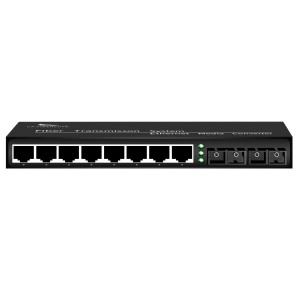
-300x300.jpg)
